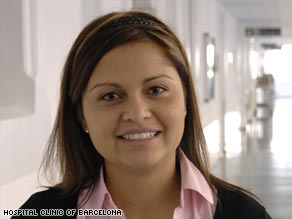Stem cell science becomes stem cell medicine
Colombian woman gets new windpipe from her own stem cells
 A Colombian woman has become the world’s first recipient of an organ grown in the laboratory from stem cells. The windpipe (bronchus), of Claudia Castillo, 30, had collapsed because she had suffered from tuberculosis. Scientists at the Hospital Clinic of Barcelona created a new windpipe from her own stem cells and transplanted it. The operation appears to be a success and Ms Castillo needs no immune suppressant drugs because the stem cells were her own.
A Colombian woman has become the world’s first recipient of an organ grown in the laboratory from stem cells. The windpipe (bronchus), of Claudia Castillo, 30, had collapsed because she had suffered from tuberculosis. Scientists at the Hospital Clinic of Barcelona created a new windpipe from her own stem cells and transplanted it. The operation appears to be a success and Ms Castillo needs no immune suppressant drugs because the stem cells were her own.
Roger Highfield, editor of the New Scientist, expressed the jubilation of many scientists: "The science of healing is developing so quickly that it has become almost a cliché to describe a particular operation as a ‘breakthrough’. Yet there is no doubt that the first successful transplant of a human windpipe, constructed partly from stem cells, is an astonishing milestone – one that could indeed mark the start of a new era in medicine."
With the noisy debate over the relative importance of embryonic versus adult stem cells hushed as hopes for the former fade, almost none of the news reports pointed out that only adult stem cells had been used in this stunning development.
Professor Martin Birchall, a member of the team from the University of Bristol, said: "What we’re seeing today is just the beginning. This is the first time a tissue-engineered whole organ has been transplanted into a patient. I reckon in 20 years’ time, it will be the commonest operation surgeons will be doing. I think it will completely transform the way we think about surgery, health and disease."
The technique, he said, could be applied to other hollow organs, such as the bowel, bladder and reproductive tract.
What the scientists did was to remove a windpipe from a deceased donor and scrub away all the soft tissue so that all that remained was a scaffolding of cartilage. Then they seeded this with stem cells from bone marrow and the nose. These grew around the scaffolding to form the new windpipe.
Professor Paolo Macchiarini, the surgeon, said: "We are terribly excited by these results. Just four days after transplantation, the graft was almost indistinguishable from adjacent, normal bronchi." ~ Scotsman, Nov 19
- Queensland legalises ‘assisted dying’ - September 19, 2021
- Is abortion a global public health emergency? - April 11, 2021
- Dutch doctors cleared to euthanise dementia patients who have advance directives - November 22, 2020
